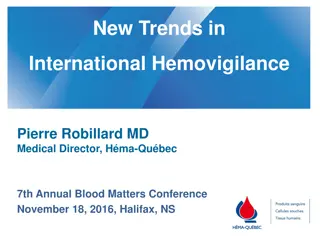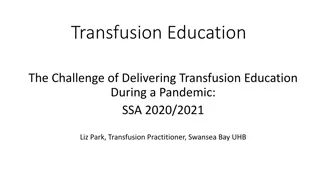Understanding Non-Transfusion-Dependent Thalassemia
Delve into the complexities of Non-Transfusion-Dependent Thalassemia as explained by Dr. Ashutosh Lal, MD, from the Northern California Thalassemia Center at UCSF Benioff Children's Hospital Oakland. Explore the various Thalassemia syndromes, patient profiles, causes, and transfusion requirements associated with this condition. Gain insights into the continuum of treatments ranging from regular transfusions for survival to intermittent transfusions and even no transfusions. Discover the age profiles and distribution of patients in Oakland along with the proportion of different thalassemia types. Uncover the intricacies of beta mutations, Hb E mutations, alpha gene deletions, and more.
Download Presentation

Please find below an Image/Link to download the presentation.
The content on the website is provided AS IS for your information and personal use only. It may not be sold, licensed, or shared on other websites without obtaining consent from the author. Download presentation by click this link. If you encounter any issues during the download, it is possible that the publisher has removed the file from their server.
E N D
Presentation Transcript
Non-Transfusion- Dependent Thalassemia Ashutosh Lal, MD Northern California Thalassemia Center UCSF Benioff Children s Hospital Oakland
Thalassemia Syndromes: Many diagnoses Thalassemia Syndromes: Many diagnoses ATRX 0.5% Thal Major 38% Hb H 19% Hb H/CS 8% A Thal Major 0.5% Thal Int 11% C 0 0.5% E + 6% A Trip/ Thal Trait 2% E 0 14% Oakland Data (n=203)
What is the proportion of What is the proportion of non non- -transfusion transfusion- -dependent thalassemia dependent thalassemia Non-transfused 27% Transfusion- dependent 56% Intermittently- transfused 17% Not a true representation of NTDT The real number of non-transfused patients is likely 5-10 times n=203, Oakland data
Age profile of patient population in Oakland Many non-transfusion-dependent patients stop regular follow up 30 50 Transfusion-Dependent Non-Transfusion-Dependent Female Female 40 Male Male Number of patients Number of patients 20 30 20 10 10 0 0 5 15 25 35 45 55 65 5 15 25 35 45 55 Age (years) Age (years) Oakland data
Thalassemia Syndromes: Thalassemia Syndromes: a continuum a continuum Regular Transfusions for Symptoms Regular Transfusions for Survival Occasional Transfusions No Transfusions Trait Intermedia Major
Causes of Causes of Non Non- -Transfusion Dependent Thalassemia Transfusion Dependent Thalassemia Beta 0 and mild beta mutation Two mild beta mutations Two beta mutations plus high fetal hemoglobin One beta mutation plus increased alpha genes Single unstable beta mutation Beta Thalassemia Intermedia Hb E mutation with beta mutation E and beta mutations with alpha deletion E and beta mutations with high fetal hemoglobin E-Beta Thalassemia Deletion of three alpha genes Deletion of 2 alpha genes plus mutation in one alpha gene Alpha Thalassemia
Transfusion Requirement Transfusion Requirement N e v e r 8 0 In te r m itte n t N u m b e r o f p a t ie n t s R e g u la r 6 0 4 0 2 0 0 H e te r o H b H H b H /C S T h a l E 0 E + T h a l In te r m e d ia T h a l T h a l Oakland data
Beta Beta- -thalassemia intermedia: thalassemia intermedia: Evolving Management Evolving Management Thal Int, 42 years old Thal Int, 16 years old Diagnosed at 2 years Hemoglobin 6-7 g/dL No blood transfusions Good energy level, participates in sports, swimming and soccer At 14 years: Fatigue, splenomegaly, growth delay No response to hydroxyurea Started on regular transfusions Diagnosed at 1 year Hemoglobin 6-7 g/dL No blood transfusions At 10 years: heart failure Splenectomized Hemoglobin increased to 8 Intermittent transfusions At 30 years: Pulmonary hypertension, right heart failure Started on regular transfusions
E E- -Beta Beta0 0 Thalassemia Thalassemia 11 years old, diagnosed with E beta thalassemia at 2 years Well during infancy Sick as toddler frequent ER visits for fever; pneumonia School: Tired compared with peers, needs frequent rest, chooses less active play 3 transfusions in one winter: fall in hemoglobin during infections Baseline hemoglobin from 5.8 to 6.5 g/dL No response to HU Started on regular transfusions at 6 years E E- -Beta Beta0 0 Thalassemia plus alpha Thalassemia plus alpha0 0 trait trait Younger brother 8 years old Hemoglobin level 9.8 g/dl Asymptomatic
Heterozygous Beta thalassemia intermedia Heterozygous Beta thalassemia intermedia Now 36 years old: Dx at 8 months: a little pale, fatigued, poor appetite Baseline hemoglobin level 7.5 to 9 g/dL First transfusion at 18 years for aplastic crisis. Cholecystectomy at 22 years, transfusion prior to surgery Pregnancy at 34 years, hemoglobin dropped from 7 to 4 g/dL, transfused intermittently during pregnancy Liver 4 cm, Spleen 8 cm Hemoglobin 6.9 g/dL Ferritin 1830; Liver iron concentration 31.2 mg/g dry-wt Electrophoresis: Hb A2: 4.8%, Hb F 1.2% Globin gene: Heterozygous IVSI-1, G->A ( 0/ A) Heterozygous alpha anti-3.7 triplication ( / ) Globin gene:
HbH HbH Constant Spring Constant Spring Age in years Transfusion Events Transfusion Events
Comparison with Thalassemia Major More in thalassemia major Iron overload Early need for effective chelation Consequences of iron overload Endocrinopathies Hypogonadism Osteoporosis Heart disease Liver disease Transfusion-transmitted infections Hospital visits More in non-transfusion dependent thalassemia Anemia Sudden fall in hemoglobin Extramedullary masses Splenomegaly Pulmonary hypertension Thrombosis Leg ulcers Silent Cerebral Infarction
Clinical Management Guidelines Oakland Standards of Care
The initial clinic visit The initial clinic visit Review laboratory results Hematological Electrophoresis DNA tests Counseling Discuss probable outcome and uncertainties Stress that close follow up is essential to make informed decisions Introduce the care team Physician, Nurse Practitioner, Social Worker, Clinic Coordinator, Dietician, Genetic Counselor Provide support
Montioring Montioring Frequency of visits Initially every month, then 2 months, then 3-12 months Growth Height and weight, pubertal development Nutrition Folate, vitamin D, avoiding supplemental iron Counseling for risk during infections Building relationship Accessibility, social work assessment, diagnosis card
Management of Fever Management of Fever Two major risks during fever Worsening of anemia Serious sepsis Patients with fever >100.4 F seen on the same day Exception Deletional hemoglobin H disease can be seen next day During the clinic or ER visits Check hemoglobin, reticulocyte count and bilirubin Admit for observation or transfusion if the hemoglobin low Antibiotic treatment may be needed Splenectomized patients with a fever Should be seen on the same day Given a dose of intravenous antibiotic, admission recommended
Options for treatment Options for treatment Observation and supportive care Folate, nutrition, regular monitoring Hydroxyurea Other experimental agents to increase fetal hemoglobin Splenectomy Regular transfusions Alternatives to long-term transfusions Bone marrow transplantation Gene Therapy
Splenectomy Splenectomy Splenectomy is NOT recommended as a means to delay or prevent the need for regular transfusions Hb H Constant Spring is an exception Splenectomized Non-Splenectomized 30 25 Number of Patients 20 15 10 5 E Beta Thalassemia Oakland data 0 Never Occasional Regular
Hydroxyurea Hydroxyurea Benefit of Hydroxyurea is uneven Certain mutations predict better response to hydroxyurea XmnI polymorphism Lepore or -thalassemia Patients with extramedullary pseudotumors Hydroxyurea starting dose of 10 mg/kg/day, not exceeding 20 mg/kg/day Response evaluated after 3 and 6 months of therapy Hemoglobin level increase of >1 g/dl at 6 months Discontinue in patients not showing response
Specific Management: Specific Management: Assessing the need for transfusions Assessing the need for transfusions Growth problems Fatigue Quality of life Splenomegaly Extramedullary hematopoiesis Pulmonary Hypertension Pain Intermittent transfusions Recommended when hemoglobin falls <6 g/dL Frequent episodes mean regular transfusions needed
Transfusion therapy: When to transfuse Transfusion therapy: When to transfuse Patients with hemoglobin consistently <7 g/dL should start regular transfusions Beta thalassemia E Beta Thalassemia Many patients do well with hemoglobin 6-7 g/dL Consider growth, fatigue, splenomegaly Hemoglobin H Disease Transfusions are not necessary for management Hemoglobin H Constant Spring Intermittent transfusions are generally needed Regular transfusions are usually not recommended
Iron Overload Iron Overload Development of iron overload is inevitable, irrespective of transfusion status Extra iron is absorbed from food Iron deposition is cumulative and age-dependent Serum ferritin under-estimates the liver iron Cardiac iron deposition less common L iv e r Ir o n C o n c e n t r a t io n Liver damage Hormone deficiencies 4 0 3 0 m g /g 2 0 1 0 U p p e r L im it 0 T h a l T h a l T h a l T h a l Oakland data: NTDT patients N o T x In t T x N o T x In t T x
Assessment of Iron Overload Assessment of Iron Overload Measure serum ferritin Measure liver iron concentration when ferritin >300 ng/mL Measure cardiac iron if LIC >15 mg/g Evaluate for hormone deficiencies Treatment of Iron Overload Treatment of Iron Overload Non-transfused patients >10 years with ferritin >300 ng/mL and LIC >5 mg/g Earlier for intermittently transfused patients Deferasirox is the preferred chelators Dose is 50% of that used for thalassemia major Goal: reduce ferritin <200 ng/mL, LIC <5 Stop therapy, resume monitoring
Fertility Fertility Fertility is usually not affected Genetic Counseling: Partner testing is essential Pregnancy Pregnancy: Consider transfusions during pregnancy when hemoglobin <8 g/dL Quality of Life Quality of Life Monitored for deterioration in QOL with age Chronic fatigue, difficulty in coping at work Family stress Chronic pain Psychosocial assessment, support and counseling Barriers to Care Barriers to Care Lack of regular follow up Lack of evaluation at Comprehensive Thalassemia Center Lack of medical insurance
Northern California Comprehensive Thalassemia Center Elliott Vichinsky, MD Medical Director of Hem/Onc Ashutosh Lal, MD Director of Thalassemia Program Lynne Neumayr, MD Administrative Director Sylvia Titi Singer, MD Associate Hematologist Carolyn Hoppe, MD Director, Hemoglobin Ref Lab Drucilla Haines, PNP Clinical Nurse Practitioner Wendy Murphy, MSW Thalassemia Social Work Laurice Levine, MA, CCLS Thalassemia Outreach Shanda Robertson Database Manager Ellen Fung, PhD Nutrition Scientist Marcela Weyhmiller, PhD Iron Program























